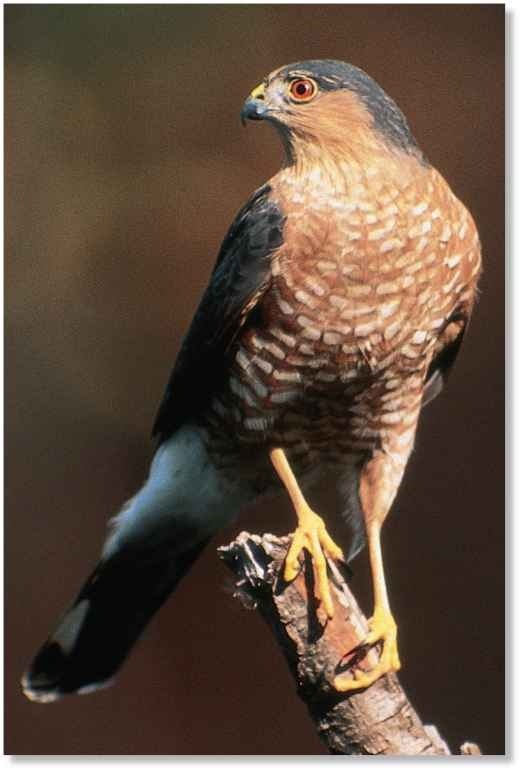ORDER
Falconiformes
FAMILY
Accipitridae
GENUS & SPECIES
key features
• Hunts by ambushing its prey; sometimes
drowns its victim in nearby watering holes
The male chooses a new nest site each year and builds most of the nest
• Females begin laying their eggs on the same day each year
• The eyes undergo several color changes, which also indicate the bird’s age
where in the world?
Found in much of North America, including British Columbia, ontario, Nova scotia and the U.S.; south through 5 Mexico and Costa Rica to Colombia in South America

Lifecycle
The Cooper’s hawk preys on small birds and mammals, often hunting from a perch or flying around the edges of a forest clearing before pouncing on its victim.
HABITAT
The Cooper’s hawk prefers deciduous and coniferous forests dotted with meadows and clearings; there, the bird can glide freely to the ground. Found in most of North America, the hawk inhabits areas close to water. Large expanses of farmland are another favored residence, giving the bird plenty of open areas and a chance to capture domesticated fowl. On nesting grounds, the hawk lives in wilderness forests and in farm woodlots. In October, some populations of the Cooper’s hawk migrate to New England and farther south to Costa Rica and Colombia. The main migration ► Living among the trees northward to the breeding The Cooper’s hawk inhabits woods occurs in March. the forests of North America.
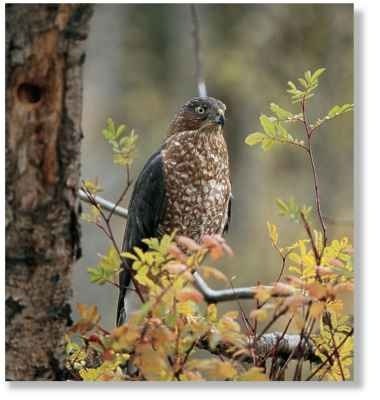
FOOD & HUNTING
The Cooper’s hawk hunts mainly by waiting on its perch until it spots its prey, usually small birds or small mammals like chipmunks or red squirrels. It surprises its victim by swooping down silently, then striking with its talons; it has sometimes been known to bring its captured but still-living prey to a watering hole and drown it. When pursuing birds, this hawk flies swiftly while darting through the trees. Typical prey includes bobwhite quails, starlings, robins and blackbirds. The hawk boldly attacks farm poultry, which is why farmers refer to it as the chicken hawk. The Cooper’s hawk regurgitates pellets containing indigestible material, such as bones and fur.
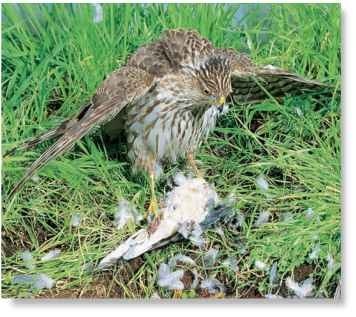
A Clearing the table The hawk takes its prey to a clearing to be eaten.
PERCH AND POUNCE
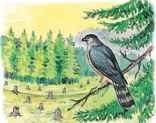
1 From the perch…
The Cooper’s hawk perches on a conifer branch at the edge of a clearing where it will wait patiently until its prey appears.
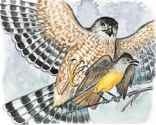
2 Total surprise…
With its prey in sight and within range, the Cooper’s hawk pounces on the crested flycatcher, catching it by surprise.
BEHAVIOR
The Cooper’s hawk makes its presence known through a series of loud cack-cack-cack calls; when danger is near; it emits a piercing call. The bird is able to dart and dash through the woods with great ease; twisting and turning through the branches. Its short, round wings and long; narrow tail are suited for complex maneuvers in the pursuit of prey or during aerial courtship displays, which include rapid circling while flapping and gliding. Some populations remain sedentary, but most northernpopulations of the Cooper’s hawk migrate south for the cold winter months.
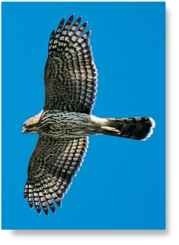
A Flying high A powerful flier, the hawk soars through the air.
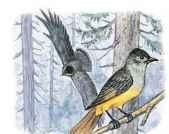
3 Around the bend…
The hawk dashes around the trees at high speeds, twisting and turning along the forest’s edge until it spots a crested flycatcher.
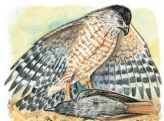
4 Nowhere to hide
On the ground with its victim, the Cooper’s hawk holds its prey with its feet before tearing meat off the bird with its strong bill.
CONSERVATION
Numbers of the once-plentiful Cooper’s hawk have dwindled as a result of habitat loss and pesticides, particularly in the eastern deciduous forests. Hawks are protected by federal law in the U.S.
# Sometimes chicks mistake the adult’s red eye for a piece of meat and peck at it using their sharp bills.
# The Cooper’s hawk can attain flight speeds of up to 55 mph, especially when in hot pursuit of prey such as small birds.
BREEDING
Males defend territories during the breeding season, where they wait for a mate. When a female arrives, the male feeds her Both sexes perform courtship displays, often flying with wings lifted high. The pair sings melodious duets, sometimes lasting up to an hour at a time. The male selects and builds the nesting site each year where the female lays 3-6 (usually 4-5) eggs. Incredibly the eggs are laid on the same day each year; they are dull white or spotted brown or green.The eggs lie in a nest of sticks and twigs, usually 20-50′ above the ground in both pine and hardwood groves or in cottonwoods and sycamores along streams. The female incubates alone for 30-34 days and remains very close to the chicks for the first few weeks. Chicks are born with soft, white down. Males do not approach the nest; instead, they meet the female nearby and provide
food for the hatchlings. Within 27-30 days, the birds are ready to fly from the nest. Young females usually breed while still in their immature plumage at 1 year; males typically breed after attaining adult plumage at 2 years of age.
On guard The female keeps a close eye on her chicks for their first few weeks.
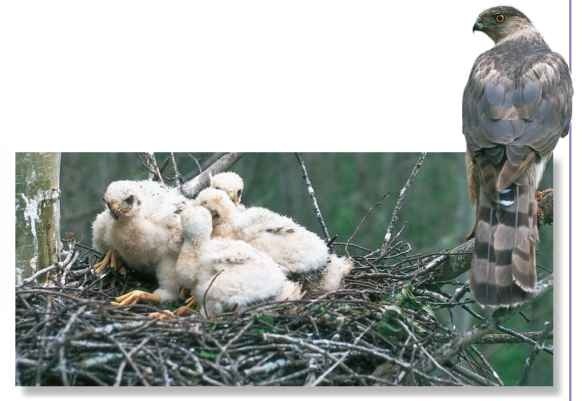
Profile
Cooper’s Hawk
With its long tail and short, rounded wings, the Cooper’s hawk flies swiftly as it darts through the trees in pursuit of prey.
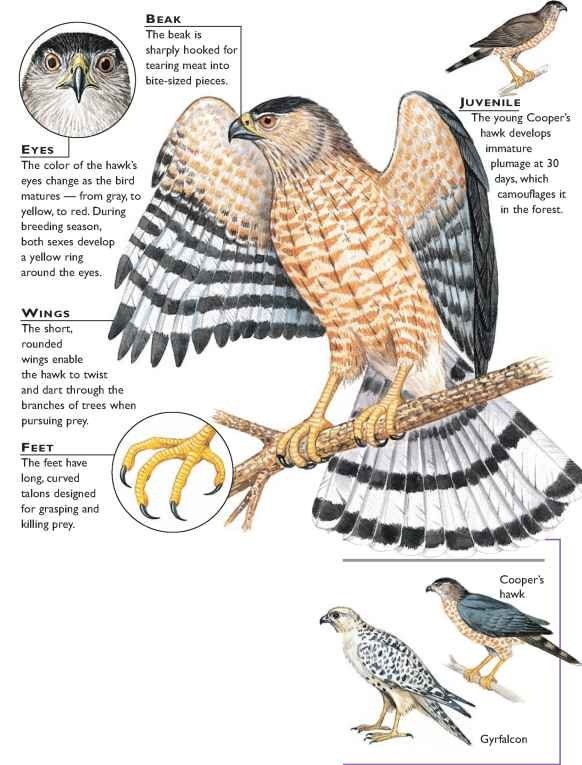
CREATURE COMPARISONS
The gyrfalcon (Falco rusticolus) is a close relative of the Cooper’s hawk. Reaching up to 24″ long, with a wingspan up to 4.5′ and weighing over 4 lbs., the gyrfalcon is the world’s largest falcon and is larger than the Cooper’s hawk Unlike the hawk, which has only one color phase, the gyrfalcon occurs in three phases — white, gray and blackish-brown.The gyrfalcon inhabits the cliffs of the Arctic tundra regions of Europe, Asia, North America, Greenland and Iceland; the Cooper’s hawk prefers the forest and woodlands of North America.
| vital Weight |
statistics Female 14-22 oz.; male 8-11 oz. |
| Length | 14-20″ |
| Wingspan | 35-39″ |
| Sexual Maturity | 1-2 years |
| Breeding Season | February -July |
| Number of Eggs | 3-6 |
| Incubation Period | 30-34 days |
| Fledging Period | 27-30 days |
| /Breeding 1 Interval | 1 year |
| Typical Diet | Small birds and small mammals |
| Lifespan | 8 years or more |
Related species
• The Cooper’s hawk is M I of 50 species in the genus Accipiter, including the northern goshawk, A. gentilis, the crested goshawk, A. trivirgatus, and the bicolored hawk, A. bicolor. The family Accipitridae contains 237 species in 64 genera. There are 271 species in 5 families of falcons, eagles, hawks, vultures, condors, kites and osprey in the order Falconiformes.
